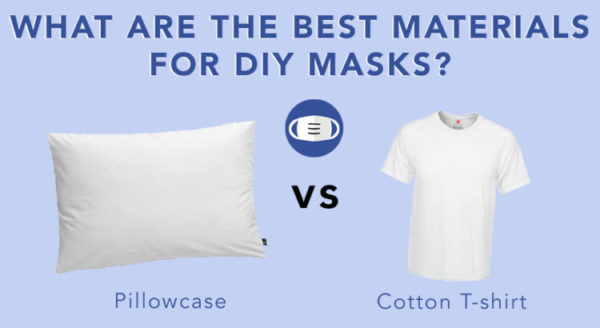

With masks sold out during the coronavirus outbreak, many people will have to make do with what some scientists have called “the last resort”: the DIY mask.
Data shows that DIY and homemade masks are effective at capturing viruses. But if forced to make our own mask, what material is best suited to make a mask? As the coronavirus spread around China, netizens reported making masks with tissue paper, kitchen towels, cotton clothing fabrics, and even oranges!
The Best Material for Making a Homemade DIY Mask
Researchers at Cambridge University tested a wide range of household materials for homemade masks. To measure effectiveness, they shot Bacillus atrophaeus bacteria (0.93-1.25 microns) and Bacteriophage MS virus (0.023 microns in size) at different household materials.
They measured what percentage the materials could capture and compared them to the more common surgical mask.
Not surprisingly, the surgical mask performed best, capturing 97% of the 1-micron bacteria. Yet every single material filtered out at least 50% of particles. The top performers were the vacuum cleaner bag (95%), the dish cloth (“tea towel” in the UK! 83%), the cotton blend shirt fabric (74%), and the 100% cotton shirt (69%).
Homemade Masks vs. Viruses
The test above used bacteria that were 1 micron large, yet the coronavirus is just 0.1 microns – ten times smaller. Can homemade masks capture smaller virus particles? To answer this question, the scientists tested 0.02 micron Bacteriophage MS2 particles (5 times smaller than the coronavirus).

On average, the homemade masks captured 7% fewer virus particles than the larger bacteria particles. However, all of the homemade materials managed to capture 50% of virus particles or more (with the exception of the scarf at 49%).
Coronavirus & Mask Livestream
Wondering whether masks work to protect you against the coronavirus? Check out our livestream recap covering all the info here!
Are Two-Layered DIY Masks More Effective?
If the problem is filtration effectiveness, would the masks work better if we doubled up with two layers of fabric? The scientists tested virus-size particles against double-layered versions of the dish towel, pillow case, and 100% cotton shirt fabrics.

Overall, the double layers didn’t help much. The double-layer pillowcase captured 1% more particles, and the double-layer shirt captured just 2% more particles. Yet the extra dish cloth layer boosted performance by 14%. That boost made the tea towel as effective as the surgical mask.
Looking at the data, the dish towel and vacuum cleaner bag were the top-performing materials. However, the researchers didn’t choose these as the best materials for DIY masks:
Instead, they concluded the pillowcase and the 100% cotton t-shirt are the best materials for DIY masks. Why?
The Importance of DIY Mask Breathability
The answer lies in breathability. How easy it is to breathe through your mask is an important factor that will affect how comfortable it is. And comfort isn’t merely a luxury. Comfort will influence how long you can wear your mask.
Fortunately, in addition to particle effectiveness, the researchers tested the pressure drop across each type of fabric. This gives us a good indication of how easy it is to breathe through each material. As a benchmark, they compared breathability of each DIY mask material to the surgical mask.
Although the tea towel and the vacuum bag captured the most particles, they were also the hardest to breath through. With two layers, the tea towel was over twice as hard to breathe through as the surgical mask. In contrast, the pillow case, t-shirt, scarf, and linen were all easier to breathe through than the surgical mask.
Researchers’ Pick for Best-Performing Homemade Mask Material
Based on particle capture and breathability, the researchers concluded that cotton t-shirts and pillow cases are the best choices for DIY masks.
Are there any other materials we can use? The Cambridge researchers left out one common material: paper towel. We tested how well paper towel masks capture sub-micron particles.
Making DIY Masks with Household Materials
Bottom line: Test data shows that the best choices for DIY masks are cotton t-shirts, pillowcases, or other cotton materials.
These materials filter out approximately 50% of 0.2 micron particles, similar in size to the coronavirus. They are also as easy to breathe through as surgical masks, which makes them more comfortable enough to wear for several hours.
Doubling the layers of material for your DIY mask gives a very small increase in filtration effectiveness, but makes the mask much more difficult to breathe through.
Here’s What Else You Should Know About DIY Masks
Still not sure if DIY masks really work? See the real-world test data on the effectiveness of homemade DIY masks.
Related: How To Make Your Own Fabric Face Mask – Hobby Lobby
more recommended stories
 Senator Atkins Introduces Bill to Strengthen Protections for Abortion, Gender-Affirming Care Providers in California
Senator Atkins Introduces Bill to Strengthen Protections for Abortion, Gender-Affirming Care Providers in CaliforniaMarch 21, 2023 SACRAMENTO – Senate President.
 Biden: Still Not Enough Votes To Codify Abortion Rights
Biden: Still Not Enough Votes To Codify Abortion RightsHe made abortion the No. 1.
 After 50 Years Dr. Anthony Fauci is Stepping Down
After 50 Years Dr. Anthony Fauci is Stepping DownI am announcing today that I.
 Helping Families Find Formula During the Infant Formula Shortage
Helping Families Find Formula During the Infant Formula ShortageTo address infant formula shortages in.
 President Biden Announces Additional Steps to Address Infant Formula Shortage
President Biden Announces Additional Steps to Address Infant Formula ShortageMAY 12, 2022 • STATEMENTS AND.
 Gavin Newsom: California Taxpayers to Subsidize Abortion Tourism
Gavin Newsom: California Taxpayers to Subsidize Abortion TourismPublished: May 11, 2022 As California prepares.
